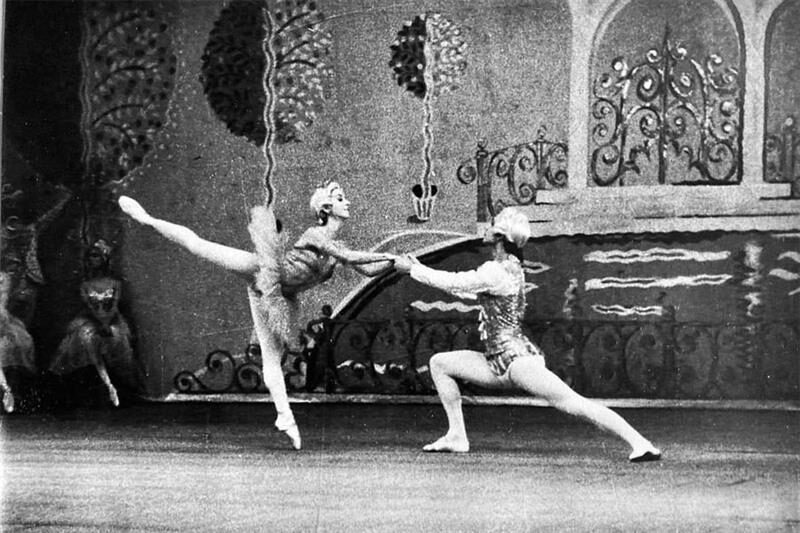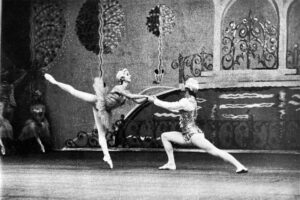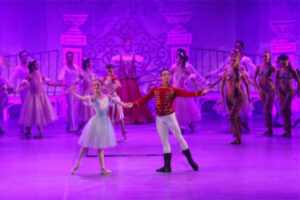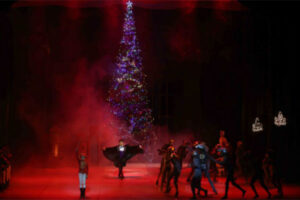
“THE MAGIC BEGINS WITH THE CLOCK STRIKING MIDNIGHT:” THE HISTORY OF THE NUTCRACKER BALLET IN EGYPT

Every year in December, the Cairo Opera Ballet Company performs The Nutcracker at the Cairo Opera House’s main hall, continuing a long tradition of performances of this magical work.
This year, the ballet will be staged on five consecutive evenings, between 26 and 30 December. Thursday, 30 December will also include a matinee performance.
The ballet is a magical story that begins with the clock striking midnight…
A little girl named Clara receives a mechanical doll for Christmas. When midnight comes, Clara is transported to an imaginary world where she witnesses the battle between the King of Mice and the Nutcracker. When the Nutcracker wins, turning into a prince, he takes Clara on a journey to the Land of Snow and the Land of Sweets, inviting her to a variety of dances.
Based on the story The Nutcracker and the King of Mice by E.T.A. Hoffman, the ballet, set to music by Tchaikovsky, diverts a little from Hoffman’s text (as Pepita, choreographer, used Dumas’ revised version of The Nutcracker), but the basic plotline remains the same. We meet Clara, the Nutcracker Prince, and a Mouse King with seven heads in the middle of wonderful choreography and family performance.
Since The Nutcracker’s story begins on Christmas Eve, all around the world it is usually performed around Christmas time. And so in Egypt, The Nutcracker is staged every year, with the dawn of December.
For the Cairo Opera Ballet Company, the ballet became one of the staples of its repertoire, sought after by audiences that often fill the opera’s hall to the brim. No wonder, as a part of the magical feel of the story, the 1892 two-act ballet is filled with captivating melodies and dances.

However, the history of the Nutcracker performances by Egyptian dancers goes back to the 1960s and the Khedivial Opera House (known as Old Opera House), over two decades before it was taken onto the new opera in Zamalek and staged by the Cairo Opera Ballet Company.
In 1966, the Cairo Ballet Company was formed as part of the Academy of Arts training the first generation of Egyptian classical dancers. “The entire student body at the time (1961), participated in the Novosibirsk Ballet Company’s full-length Nutcracker at the Khedivial Opera house,” wrote Magda Saleh in her recent post on Facebook. Saleh is the first Egyptian prima ballerina, whose career was born at the Egyptian ballet troupe that held its performances at Khedivial Opera House. Much later, in 1988, she served as the first chairwoman of the new opera during its construction phase in Zamalek.
In 1971, the Egyptian ballet company presented Kingdom of Sweets, a segment from Nutcracker which includes several iconic dances: Spanish, Arabian, Chinese, Russian, and the “Waltz of the Flowers.” The performance staged at the old opera was prepared by the artistic director Anatoly Kuznetsov.
“We were invited that year to participate with Kingdom in the concert program of the Kiev Ballet on the company’s Egypt tour,” Saleh recalls in her post.
But those were the last months of the Egyptian ballet’s and other troupe’s performances at the old opera. With the burning of the Khedivial Opera House in October 1971, the entire ballet company, and hundreds of other artists, lost their homes. The following years saw a complete dismantlement of the ballet troupe. It was at the hands of Abdel Moneim Kamel, one of the stars of the first Egyptian ballet company, that this art form was restored.

Since the early 1980s, the “spiritual father of ballet,” as Kamel is referred to, returned from his years of glory in Moscow and Teatro Alla Scala in Milan and began restoring the ballet company. It was with the opening of the new opera in 1988 that the Ballet Company operating under the Academy of Arts moved to the new stage, becoming the Cairo Opera Ballet Company, the name we know today.
In fact, the ballet was among the first complete works performed by the Cairo Opera Ballet Company as it premiered in 1993. While working on The Nutcracker, Kamel provided his creative touches to the iconic work and enriched the characters. It is this version that continues to be performed throughout the years, incorporating creative ideas and a few choreography segments by Kamel into the known choreography of Marius Petipa and Lev Ivanov Pepita.
It is important to note that not only was Kamel the company’s artistic director, in the 1990s he also became Artistic Director of the Cairo Opera House and, finally, its chairman in 2004, a position he held until 2011, while Erminia Kamel became the troupe’s Artistic Director. Abdel Moneim Kamel passed away in February 2013, leaving behind generations of dancers filled with a passion for dance and dozens of ballet works, including a unique version of The Nutcracker that we can enjoy every year.
Upon its premiere at the Cairo Opera, the role of Clara was given to Erminia Kamel, while Lamia Mohamed took the role of a younger Clara. The Nutcracker’s performances have been duly repeated on an annual basis, each time featuring dancers who grew artistically, and with time, was replaced by the younger stars of the troupe.
This year, the performances will take place daily, between 26 and 30 December at 8 pm, at the Cairo Opera’s main hall. The Cairo Opera Orchestra will be conducted by Nayer Nagui.
Matinee performance: 30 December at 11 am.



